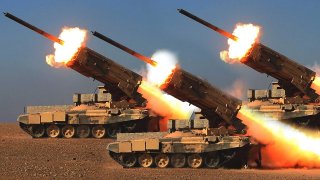WWIII Watch: Is a Second Russian Invasion of Ukraine Inevitable?
Russia has amassed over 150,000 troops on Ukraine’s border and in occupied Crimea, according to the European Union’s (EU) top diplomat Josep Borrell.
Here's What You Need to Remember: The Donbass conflict has hovered for the past five years around a kind of uneasy equilibrium: namely, neither Russia nor Ukraine wants to strike first. Doing so would be an open rebuke of the Minsk Peace accords, a political liability that neither side has been willing to accept.
As tensions continue to simmer over the ongoing Donbass conflict, Russia’s Armed Forces are staging the largest military build-up on Ukraine’s borders since 2014.
Russia has amassed over 150,000 troops on Ukraine’s border and in occupied Crimea, according to the European Union’s (EU) top diplomat Josep Borrell. "It is more than 150,000 Russian troops massing on the Ukrainian borders and in Crimea. The risk of further escalation is evident," Borell said, though he added that no additional sanctions or expulsions of diplomats are currently being planned.
The buildup began around February when some Russian units were not rotated back following military drills in Crimea. Since then, Russia’s military steadily increased its presence in Crimea and the Voronezh Region. Footage from late March shows trainloads of 2S19 Msta-S self-propelled howitzers and BMP-3 infantry fighting vehicles (IFV’s) being moved into Crimea. Iskander short-range ballistic missile systems, BM-27 Uragan rocket launcher systems, and TOS-1A rocket launchers, as well IFV’s and Msta-S units, have been spotted entering Voronezh. The 56th Guards Air Assault Brigade is likewise being deployed to Feodosia in eastern Crimea.
A vast share of Russia’s buildup consists of units from the Western Military District, but assets from the more remote southern and central districts are also deployed. Michael Kofman, director of the Russia Studies Program at the Center for Naval Analysis and a fellow at the Kennan Institute, noted the presence of forces consisting in large part of four armies and three to four Russian Airborne Forced (VDV) units, supported by field hospitals, communications infrastructure, electronic warfare units, and air defense systems. At least fourteen Russian Ground troops have moved or are moving toward the Ukrainian border since late March, according to Janes analyst Thomas Bullock.
The full extent of Moscow’s intentions behind this massive buildup remains unclear. Still, there is currently no military or political indication that Russia’s border forces are preparing for an imminent westward offensive into the Donbass region. Instead, the Kremlin’s statements and pattern of behavior are more consistent with coercive intent. The Kremlin has repeatedly suggested that Kiev could be planning a full-scale offensive to take back the separatist regions of Donetsk and Luhansk, an outcome that the Putin administration said it will not abide. Ukraine’s military has denied these accusations: “The liberation of the temporarily occupied territories by force will inevitably lead to the death of a large number of civilians and casualties among the military, which is unacceptable for Ukraine,” according to a statement issued by the chief of the general staff of the Ukrainian Armed Forces, Ruslan Khomchak.
The Donbass conflict has hovered for the past five years around a kind of uneasy equilibrium: namely, neither Russia nor Ukraine wants to strike first. Doing so would be an open rebuke of the Minsk Peace accords, a political liability that neither side has been willing to accept. In the present geopolitical context, Russia’s military buildup can be interpreted as a deterrent measure; a signal to Kiev that any possible attempt to retake Ukraine’s eastern breakaway territories by force will be met with a swift and overwhelming Russian counter-offensive.
Mark Episkopos is a national security reporter for the National Interest. This article first appeared earlier this year.
Image: Reuters

